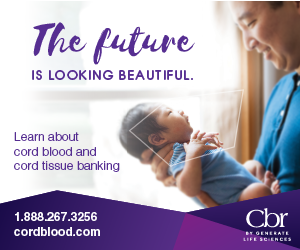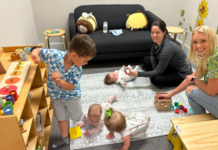My name is Erica and I am a wife, a mom, and a Cord Blood Registry (or Cbr® for short) educator! I live in Charleston but travel all over South Carolina and North Carolina sharing Cbr® information to parents and clinicians. So many parents come to me (after they have had baby and it is too late) and say “I wish I would have known about my options for cord blood and cord tissue banking” or “my doctor never really talked about cord blood and cord tissue banking with me”. I want to help clear the air and help answer some most commonly asked questions when it comes to cord blood and cord tissue banking.
 What does it mean to save cord blood and tissue stem cells?
What does it mean to save cord blood and tissue stem cells?
When you preserve your baby’s umbilical cord blood and/or tissue cells you are preserving them for future use; if you privately bank them with a company such as Cord Blood Registry or Cbr®, the cells can be potentially used by your family. If you decide to save the cord blood and donate to a public bank, those cells are meant to be used by a patient who needs a transplant. (While it is free to donate, it is highly unlikely that the cells will be available to your family for use in the future.) These cells are smart, powerful, and special! They can change into different types of cells! (That is pretty amazing). There are two different types of cells found in the cord blood and tissue. Cord blood is a rich source of the type of stem cells (Hematopoietic) that become all of the cells that make up our blood and immune systems like red blood cells, white blood cells, and platelets. Since we collect different types of stem cells from cord blood and cord tissue, there are some differences in the potential options for treatment.
Today, cord blood stem cells have been used in more than 40,000 transplants, worldwide, to regenerate healthy blood and immune systems. Researchers are also investigating the use of cord blood stem cells in regenerative medicine, to help repair and regenerate damaged tissue. Like cord blood, cord tissue also contains stem cells (called Mesenchymal). Cord tissue is rich in a different type of stem cell that can become cells of connective tissue of the body like muscle, cartilage, bone, and fat. These newborn stem cells may help heal the body in different ways. Researchers are excited about the benefits cord tissue stem cells may offer in potential future uses, such as regenerative medicine. Some medical conditions being investigated in regenerative medicine include neurological conditions like brain injury and autism, cardiovascular conditions like hypoplastic left heart syndrome, autoimmune diseases like type 1 diabetes, MS, and lupus, and even tissue or organ damage. These clinical trials are occurring both in the US and around the world.
What is the medical process and how exactly are the blood/cells collected?
When you decide to enroll with Cbr® (by either going online to www.cordblood.com or calling us at 1.888.932.6568) we gather all your information and send you a kit. Let your physician or midwife know you plan on collecting and when it is time for baby to arrive, bring your kit to the hospital! Your provider will perform the collection (simple, fast, and pain-free!) and then pack the cord blood and/or tissue int the collection kit. Have dad/partner/support person call the courier who will them get the kit and send to our lab. Once the lab received the kit parents will be notified once their cells are safely stored!
What is the storage process – How does it work? How long does it last? How much does it cost?
Storage process:
Once we receive the Cbr® collection kit we process the sample and prepare it for storage. Our lab and storage facility is in sunny Tucson, Arizona, which is at low risk of earthquakes, tornadoes, and other natural disasters! I encourage everyone to watch our virtual lab tour, it is pretty amazing. WHERE the stem cell lab is located and HOW a lab processes and stores these powerful stem cells is an extremely important factor when choosing a private bank. Cbr® has two 9,000 gallon liquid nitrogen tanks onsite to provide a constant resupply for keeping the cord blood and cord tissue safely frozen (our storage tanks are a chilly -320.8°F (-196°C)!). We run sophisticated monitoring and temperature checks every 1.6 seconds and have one of the largest backup generators available to power all critical systems in the event of a loss of electricity.
How long does it last?
Based on the information we have today, if stored under the proper conditions, cord blood stem cells should not have an “expiration date” and can be stored indefinitely. A publication by Dr. Broxmeyer and colleagues showed that cord blood stem cells that had been in cryostorage for 21-23.5 years behaved similarly to freshly collected cells.
How much does it cost?
I always tell my providers to tell their patients to call me about pricing; I can offer special pricing on the processing fee. Once the units are processed and stored parents only pay a YEARLY storage fee. There are so many pricing options! Make sure to call your local rep (me!) for updated savings. We have multiple payment plans and options for our families.
 What are the benefits of saving cord blood and cord tissue stem cells and what are the drawbacks?
What are the benefits of saving cord blood and cord tissue stem cells and what are the drawbacks?
Preserving your newborn’s stem cells can help you prepare for your child’s and/or family’s future. This financial investment provides you access to a unique resource that may open doors to future stem cell treatments for your family as well! Cord Blood and Tissue collection is a safe, painless way to collect and store these powerful cells! The only drawback about preserving your newborn’s stem cells is if you DON’T preserve them and need them in the future! Families are often misinformed regarding public donation; it is pretty unlikely that your donated newborn’s cord blood cells will ever be available to you after donation and on average 70%-90% of the donations are actually discarded. Also, currently only cord blood is accepted at public banks, cord tissue is not. It is important to note we do not have any hospitals in South Carolina that partner with the Be the Match program for public cord blood donations.
Can we practice delayed cord clamping and still preserve our newborn’s cord blood stem cells?
Yes! It is possible to practice DCC and still collect cord blood. Cbr® does not ask that families or their providers change their birthing plan in any way. An informal query with Cbr® providers who routinely practice DCC indicate that they have been able to collect sufficient cord blood for storage as well. As always, the provider should start the cord blood collection as soon as the cord has been clamped and cut. DCC has no bearing on the ability to collect cord tissue so if you decide to fully delay you can always have your provider collect the cord tissue.
Does the entire cord blood sample have to be used for a stem cell transplant?
It depends. The patient’s treating physician will always determine the number of cells that are required for a given treatment. Depending on the specific use, the entire sample may be needed or it might be possible to save some of the sample for potential future use. For this reason, CBR stores the cord blood samples in a storage bag with multiple compartments. That said, if we are talking about using the cord blood in a hematopoietic stem cell transplant (i.e. transplant medicine), more than likely the entire sample will be needed. This may not be the case for experimental regenerative uses.
What is the likelihood that two siblings are a good match for each other? What about parents?
Full siblings have up to a 75% chance to be at least a partial match to each other: a 25% chance to be a perfect match and a 50% chance to be a half (partial) match. Parents are always a half (partial) match to their children. In cord blood transplants, it may be possible to use cells from a donor who is a partial match.
Why should I preserve my baby’s newborn stem cells if my family doesn’t have a history of medical conditions or diseases?
Many of the 80+ conditions that cord blood can be used to help treat today do not run in families (such as leukemia or aplastic anemia to name a couple). Also, the conditions for which cord blood and/or cord tissue are being evaluated to treat are most often conditions that are acquired throughout the lifetime and do not run in families (such as stroke, acquired hearing loss, and brain injury.)
Does COVID impact my ability to bank with Cbr®?
NO! You can still preserve your baby’s stem cells at Cbr® Our lab remains fully operational and our medical courier will pick up the kit from your hospital. The samples are also safe with CBR. We have always had multiple safeguards in place to prevent cross-contamination and exposure to infectious diseases. Each stored sample has a protective overwrap so they are effectively stored in an individual quarantine. Also, it is important to note that Mesenchymal stem cells (MSCs), like those obtained from cord tissue, have been investigated for inflammation and lung disease for many years. Researchers are applying the knowledge we’ve already gained about how MSCs help to reduce inflammation to the current COVID-19 situation. Small clinical trials are already underway to see if MSCs could help COVID-19 patients. Read about the exciting partnership between Cord Blood Registry® here on our blog!
How do I learn more about preserving my baby’s stem cells?
You can call me directly at (843) 323-7950 or you can call 1-888-CORDBLOOD and speak to a Newborn Stem Cell Educator who can assist you in the enrollment process. I also encourage all expecting families to visit our website at www.cordblood.com and follow us on social media! We have a corporate Instagram page @cordbloodregistry and my local page is @lowcountrycordblood (I share more local events and special pricing offers).
 Erica Hoppenrath is the local consultant for Cord Blood Registry in areas of South Carolina and North Carolina. She has been guiding parents and educating providers on the benefits of umbilical cord stem cell preservation for 3 ½ years. Erica lives in the Charleston area with her husband, son (who is currently a junior at the University of South Carolina, Go Gamecocks!), pup and cat. She enjoys talking one on one with her parents, so if you are expecting and want to learn more about the power and potential of stem cells, reach out to her today!
Erica Hoppenrath is the local consultant for Cord Blood Registry in areas of South Carolina and North Carolina. She has been guiding parents and educating providers on the benefits of umbilical cord stem cell preservation for 3 ½ years. Erica lives in the Charleston area with her husband, son (who is currently a junior at the University of South Carolina, Go Gamecocks!), pup and cat. She enjoys talking one on one with her parents, so if you are expecting and want to learn more about the power and potential of stem cells, reach out to her today!














